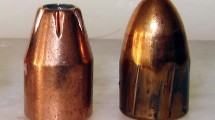Abstract
Few studies have examined the biomechanical basis for backspatter from cranial gunshot wounds. Backspatter is material which travels against the direction of fire following ejection from a gunshot entrance wound. Our paper focuses on the use of animals for reconstructing this phenomenon. Five live pigs and several slaughtered pigs were shot using either 9 × 19 mm, 115 grain, full metal jacketed ammunition or .22 long rifle, 40 grain, lead, round-nose ammunition. A high-speed camera was used to record the entrance wound formation and backspatter. A small amount of backspattered material was produced with all targets, and blood backspatter was seen in a few cases. However, we conclude that our model provides an understanding of the phenomenon of backspatter and the physical mechanisms associated with it. The various components of the mechanism of backspatter formation are complex and overlap. The principle mechanism observed in pig cranial gunshots was the high-speed impact response of the skin overlying the skull bone. This study has also produced evidence supporting the view that backspatter can result from the splashing of superficial blood if it is already present on the skin. Subcutaneous gas effects have been demonstrated for backspatter from contact shots. There has been no clear evidence of the role of the collapse of a temporary cavity within the brain.







Similar content being viewed by others
References
SWGSTAIN (2009) Recommended terminology. Forensic Sci Commun 11(2)
Karger B, Nusse R, Bajanowski T (2002) Backspatter on the firearm and hand in experimental close-range gunshots to the head. Am J Forensic Med Pathol 23(3):211–213
Werkgartner A (1924) Eigenartige Hautverletzungen durch Schüsse aus angesetzten Selbstladepistolen. Beitr Gerichtl Med 6:148–161
Betz P, Peschel O, Stiefelb D, Eisenmenger W (1995) Frequency of blood spatters on the shooting hand and of conjunctival petechiae following suicidal gunshots wounds to the head. Forensic Sci Int 76:47–53
Weimann W (1931) Über das Verspritzen von Gewebsteilen aus Einschuβöffnungen und seine kriminalistische Bedeutung. Dtsch Z Gesamte Gerichtl Med 17:92–105
Pollak S, Rothschild MA (2004) Gunshot injuries as a topic of medicolegal research in the German-speaking countries from the beginning of the 20th century up to the present time. Forensic Sci Int 144(2–3):201–210
Peschel O, Rothschild MA, Mützel E (2010) Blutspuren bei Schussverletzungen. Rechtsmedizin 20(2):91–97
Zwingli M (1941) Über Spuren an der Schieβhand nach Schuβ mit Faustfeuerwaffen. Arch Kriminol 108:1–26
Krauland W (1984) Evaluation of fatal gunshot injuries (the weapon in the hand). Arch Kriminol 174(1–2):1–22
Reed GE, McGuire PJ, Boehm A (1990) Analysis of gunshot residue test results in 112 suicides. J Forensic Sci 35(1):62–68
Stone IC (1992) Characteristics of firearms and gunshot wounds as markers of suicide. Am J Forensic Med Pathol 13:275–280
Karger B, Nusse R, Schroeder G, Wustenbecker S, Brinkmann B (1996) Backspatter from experimental close-range shots to the head. I.Macrobackspatter. Int J Legal Med 109:66–74
Burnett BR (1991) Detection of bone and bone-plus-bullet particles in backspatter from close-range shots to heads. J Forensic Sci 36(6):1745–1752
Karger B, Nusse R, Troger HD, Brinkmann B (1997) Backspatter from experimental close-range shots to the head. II. Microbackspatter and the morphology of bloodstains. Int J Legal Med 110:27–30
Bustad LK, McClellan RO (1966) Swine in biomedical research. Science 152(3728):1526–1530
Douglas WR (1972) Of pigs and men and research: a review of applications and analogies of the pig, sus scrofa, in human medical research. Space Life Sci 3(3):226–234
Ankersen J, Birkbeck AE, Thomson RD, Vanezis P (1999) Puncture resistance and tensile strength of skin simulants. Proc Inst Mech Eng 213(6):493–501
Taylor MC, Laber TL, Epstein BP, Zamzow DS, Baldwin DP (2010) The effect of firearm muzzle gases on the backspatter of blood. Int J Legal Med 125(5):617–628
Thali MJ, Kneubuehl BP, Zollinger U, Dirnhofer R (2002) A study of the morphology of gunshot entrance wounds, in connection with their dynamic creation, utilizing the "skin-skull-brain model". Forensic Sci Int 125(2–3):190–194
Davidson PL, Taylor MC, Wilson SJ, Walsh KAJ, Kieser JA (2012) Physical components of soft-tissue ballistic wounding and their involvement in the generation of blood backspatter. J Forensic Sci 57:1339–1342
Monteiro-Riviere NA, Riviere J (1996) The pig as a model for cutaneous pharmacology and toxicology research. In: Tumbleson, Schook (eds) Advances in swine in biomedical research. Plenum Press, New York, p. 425–458
Simon GA, Maibach HI (2000) The pig as an experimental animal model of percutaneous permeation in man: qualitative and quantitative observations - an overview. Skin Pharmacol Physiol 13(5):229–234
Osaki S (1999) Distribution map of collagen fiber orientation in a whole calf skin. Anat Rec 254(1):147–152
Acknowledgments
This project was completed with the support of an ESR Core Funding research grant. Ethics approval was obtained from the University of Otago Animal Ethics Committee. The authors would like to thank Eryn Kwon for her comments.
Author information
Authors and Affiliations
Corresponding author
Rights and permissions
About this article
Cite this article
Radford, G.E., Taylor, M.C., Kieser, J.A. et al. Simulating backspatter of blood from cranial gunshot wounds using pig models. Int J Legal Med 130, 985–994 (2016). https://doi.org/10.1007/s00414-015-1219-x
Received:
Accepted:
Published:
Issue Date:
DOI: https://doi.org/10.1007/s00414-015-1219-x




